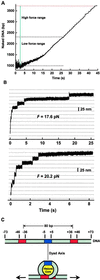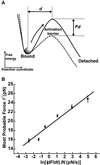Mechanical disruption of individual nucleosomes reveals a reversible multistage release of DNA
- PMID: 11854495
- PMCID: PMC122302
- DOI: 10.1073/pnas.022638399
Mechanical disruption of individual nucleosomes reveals a reversible multistage release of DNA
Abstract
The dynamic structure of individual nucleosomes was examined by stretching nucleosomal arrays with a feedback-enhanced optical trap. Forced disassembly of each nucleosome occurred in three stages. Analysis of the data using a simple worm-like chain model yields 76 bp of DNA released from the histone core at low stretching force. Subsequently, 80 bp are released at higher forces in two stages: full extension of DNA with histones bound, followed by detachment of histones. When arrays were relaxed before the dissociated state was reached, nucleosomes were able to reassemble and to repeat the disassembly process. The kinetic parameters for nucleosome disassembly also have been determined.
Figures





Comment in
-
New insights into unwrapping DNA from the nucleosome from a single-molecule optical tweezers method.Proc Natl Acad Sci U S A. 2002 Feb 19;99(4):1752-4. doi: 10.1073/pnas.062034799. Proc Natl Acad Sci U S A. 2002. PMID: 11854477 Free PMC article. No abstract available.
References
-
- Kornberg R, Thomas J. Science. 1974;184:865–868. - PubMed
-
- Luger K, Mader A, Richmond R, Sargent D, Richmond T. Nature (London) 1997;389:251–260. - PubMed
-
- Anderson J, Widom J. J Mol Biol. 2000;296:979–987. - PubMed
-
- Furrer P, Bednar J, Dubochet J, Hamiche A, Prunell A. J Struct Biol. 1995;114:177–183. - PubMed
Publication types
MeSH terms
Substances
Grants and funding
LinkOut - more resources
Full Text Sources
Other Literature Sources

